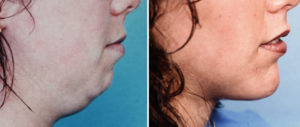It is very common that multiple procedures are done on the face at the same time. Whether it be for anti-aging effects or for reshaping a face, combinations of procedures produce more profound changes. This is because the face is made up of many different parts and making significant changes often requires altering more than one facial area.

It is easy to understand why rhinoplasty can be so important to profile changes as the nose sits at the center of the face. Even very subtle nose changes can be visually appreciated in the profile view. Lowering of the nasal bridge and reshaping the nasal tip in a large nose or augmenting the dorsal line and increasing tip projection in a smaller/flatter nose not only changes the shape of the nose but one’s profile as well.
Just like the nose the chin has an equal, if not greater, impact on one’s profile than even the nose. This is because the chin sits in the middle of the facial profile between the nose and the chin. Whether it is too small or too big, the chin influences the perception of both the nose and the neck. The nose, however, does not influence the appearance of the neck angle and a necklift does not alter the perception of one’s nose shape.
In many patients the best profile changes come from a change in the lower face. Chin surgery can improve facial proportion, creating a better balance between the upper face (forehead, nose and lips) and the neck. As a well known example, even a well shaped nose can seem larger if the face has a smaller chin. Even if some nose changes are done, the more important procedure might be chin augmentation on improving the appearance of the nose.
Chin surgery is often perceived as an augmentative operation but that is a limited view of the different types of available chin surgery. Chin augmentation historically is seen as an increased in horizontal projection, how much forward position of the chin is needed. While this can be done with either an implant to sit on top of the bone or to move the chin bone itself (sliding genioplasty), they change the shape of the chin differently. A chin implant can improve the horizontal projection of the chin but can do little for increasing the length or vertical height of the chin. Often more vertical height is needed when the chin is significantly short. Unlike a chin implant, a sliding genioplasty can not only bring the chin forward but can lengthen or shorten its vertical height as well.
While chin implants have historically lacked the ability for vertical elongation, new chin implants styles will soon be available that provide concurrent vertical lengthening as well. Rather than sitting completely on the bone, these newer designs sit on the ledge of the chin bone (halfway between the front and under edges of the chin bone) to create their effects.

Chin reduction is not as commonly done for profile changes and has a checkered history. The most common chin reduction method is done as an intraoral burring or shaving of the front edge of the chin bone. While simple, it is rarely effective as no more than a few millimeters of bone is reduced and no change occurs in the soft tissue thickness. Often patients complain of seeing no change after this surgery and may even develop some soft tissue redundancy or sagging afterwards. The use of a reverse sliding genioplasty is also ill-advised as, while it does move the whole chin bone back, it pushes the attached soft tissues into the neck creating an undesired bulge.

When considering profileplasty, or even an isolated chin augmentation or reduction procedure, the use of computer imaging is critical. It can not only confirm which procedures are beneficial but, more importantly, the magnitude of those desired changes. A plastic surgeon can never really know what ‘flavor’ of change any patient desires and such imaging helps to establish what that is. While computer imaging is never a guarantee as to how the final result will look, it provides a method of visual communication to help the surgeon not guess as to the patient’s profileplasty goals.
Dr. Barry Eppley
Indianapolis, Indiana


